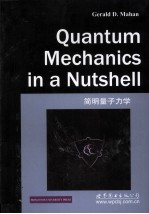图书介绍
简明量子力学=QUANTUM MECHANICS IN A NUTSHELL:英文PDF|Epub|txt|kindle电子书版本下载

- (美)马翰(MAHAN G.D.)著 著
- 出版社: 世界图书北京出版公司
- ISBN:
- 出版时间:2013
- 标注页数:399页
- 文件大小:74MB
- 文件页数:413页
- 主题词:
PDF下载
下载说明
简明量子力学=QUANTUM MECHANICS IN A NUTSHELL:英文PDF格式电子书版下载
下载的文件为RAR压缩包。需要使用解压软件进行解压得到PDF格式图书。建议使用BT下载工具Free Download Manager进行下载,简称FDM(免费,没有广告,支持多平台)。本站资源全部打包为BT种子。所以需要使用专业的BT下载软件进行下载。如BitComet qBittorrent uTorrent等BT下载工具。迅雷目前由于本站不是热门资源。不推荐使用!后期资源热门了。安装了迅雷也可以迅雷进行下载!
(文件页数 要大于 标注页数,上中下等多册电子书除外)
注意:本站所有压缩包均有解压码: 点击下载压缩包解压工具
图书目录
1 Introduction1
1.1 Introduction1
1.2 Schr?dinger's Equation2
1.3 Eigenfunctions4
1.4 Measurement8
1.5 Representations8
1.5.1 Schr?dinger Representation9
1.5.2 Heisenberg Representation10
1.6 Noncommuting Operators11
2 One Dimension14
2.1 Square Well14
2.2 Linear Potentials26
2.3 Harmonic Oscillator29
2.4 Raising and Lowering Operators34
2.5 Exponential Potential39
2.5.1 Bound State40
2.5.2 Continuum State42
2.6 Delta-Function Potential45
2.7 Number of Solutions48
2.8 Normalization49
2.8.1 Bound States49
2.8.2 Box Normalization50
2.8.3 Delta-Function Normalization51
2.8.4 The Limit of Infinite Volume54
2.9 Wave Packets56
3 Approximate Methods62
3.1 WKBJ62
3.2 Bound States by WKBJ68
3.2.1 Harmonic Oscillator71
3.2.2 Morse Potential71
3.2.3 Symmetric Ramp73
3.2.4 Discontinuous Potentials74
3.3 Electron Tunneling76
3.4 Variational Theory77
3.4.1 Half-Space Potential80
3.4.2 Harmonic Oscillator in One Dimension82
4 Spin and Angular Momentum87
4.1 Operators,Eigenvalues,and Eigenfunctions87
4.1.1 Commutation Relations88
4.1.2 Raising and Lowering Operators89
4.1.3 Eigenfunctions and Eigenvalues90
4.2 Representations95
4.3 Rigid Rotations100
4.4 The Addition of Angular Momentum102
5 Two and Three Dimensions108
5.1 Plane Waves in Three Dimensions108
5.2 Plane Waves in Two Dimensions112
5.3 Central Potentials114
5.3.1 Central Potentials in 3D114
5.3.2 Central Potential in 2D118
5.4 Coulornb Potentials119
5.4.1 Bound States119
5.4.2 Confluent Hypergeometric Functions121
5.4.3 Hydrogen Eigenfunctions121
5.4.4 Continuum States125
5.5 WKBJ126
5.5.1 Three Dimensions126
5.5.2 3D Hydrogen Atom127
5.5.3 Two Dimensions128
5.6 Hydrogen-like Atoms130
5.6.1 Quantum Defect131
5.6.2 WKBJ Derivation132
5.6.3 Expectation Values134
5.7 Variational Theory134
5.7.1 Hydrogen Atom:n=1135
5.7.2 Hydrogen Atom:e=1136
5.7.3 Helium Atom137
5.8 Free Particles in a Magnetic Field143
5.8.1 Gauges143
5.8.2 Eigenfunctions and Eigenvalues144
5.8.3 Density of States146
5.8.4 Quantum Hall Effect147
5.8.5 Flux Quantization150
6 Matrix Methods and Perturbation Theory157
6.1 H and Ho157
6.2 Matrix Methods158
6.2.1 2×2160
6.2.2 Coupled Spins160
6.2.3 Tight-Binding Model163
6.3 The Stark Effect166
6.4 Perturbation Theory170
6.4.1 General Formulas170
6.4.2 Harmonic Oscillator in Electric Field174
6.4.3 Continuum States176
6.4.4 Green's Function180
6.5 The Polarizability181
6.5.1 Quantum Definition182
6.5.2 Polarizability of Hydrogen183
6.6 Van der Waals Potential188
6.7 Spin-Orbit Interaction194
6.7.1 Spin-Orbit in Atoms195
6.7.2 Alkali Valence Electron in Electric Field199
6.8 Bound Particles in Magnetic Fields202
6.8.1 Magnetic Susceptibility204
6.8.2 Alkali Atom in Magnetic Field205
6.8.3 Zeeman Effect207
6.8.4 Paschen-Back Effect209
7 Time-Dependent Perturbations213
7.1 Time-Dependent Hamiltonians213
7.2 Sudden Approximation215
7.2.1 Shake-up and Shake-off216
7.2.2 Spin Precession218
7.3 Adiabatic Approximation220
7.4 Transition Rates:The Golden Rule222
7.5 Atomic Excitation by a Charged Particle226
7.6 Born Approximation to Scattering231
7.6.1 Cross Section232
7.6.2 Rutherford Scattering235
7.6.3 Electron Scattering from Hydrogen236
7.7 Particle Decay237
8 Electromagnetic Radiation244
8.1 Quantization of the Field245
8.1.1 Gauges246
8.1.2 Lagrangian250
8.1.3 Hamiltonian253
8.1.4 Casimir Force256
8.2 Optical Absorption by a Gas258
8.2.1 Entangled Photons268
8.3 Oscillator Strength269
8.4 Polarizability273
8.5 Rayleigh and Raman Scattering278
8.6 Compton Scattering283
9 Many-Particle Systems288
9.1 Introduction288
9.2 Fermions and Bosons289
9.2.1 Two Identical Particles290
9.3 Exchange Energy291
9.3.1 Two-Electron Systems291
9.3.2 Parahelium and Orthohelium293
9.3.3 Hund's Rules293
9.4 Many-Electron Systems295
9.4.1 Evaluating Determinants295
9.4.2 Ground-State Energy297
9.4.3 Hartree-Fock Equations299
9.4.4 Free Electrons301
9.4.5 Pair Distribution Function303
9.4.6 Correlation Energy304
9.4.7 Thomas-Fermi Theory304
9.4.8 Density Functional Theory307
9.5 Second Quantization309
9.5.1 Bosons309
9.5.2 Fermions312
9.6 Bose-Einstein Condensation313
9.6.1 Noninteracting Particles313
9.6.2 Off-Diagonal Long-Range Order314
10 Scattering Theory320
10.1 Elastic Scattering320
10.1.1 Partial Wave Analysis323
10.1.2 Scattering in Two Dimensions326
10.1.3 Hard-Sphere Scattering328
10.1.4 Ramsauer-Townsend Effect330
10.1.5 Born Approximation332
10.2 Scattering of Identical Particles333
10.2.1 Two Free Particles333
10.2.2 Electron Scattering from Hydrogen335
10.3 T-Matrices337
10.4 Distorted Wave Scattering340
10.5 Scattering from Many Particles343
10.5.1 Bragg Scattering343
10.5.2 Scattering by Fluids344
10.5.3 Strong Scattering346
10.6 Wave Packets347
10.6.1 Three Dimensions347
10.6.2 Scattering by Wave Packets348
11 Relativistic Quantum Mechanics352
11.1 Four-Vectors352
11.2 Klein-Gordon Equation354
11.2.1 Derivation354
11.2.2 Free Particle354
11.2.3 Currents and Densities355
11.2.4 Step Potential356
11.2.5 Nonrelativistic Limit356
11.2.6 П-Mesonic Atoms357
11.3 Dirac Equation360
11.3.1 Derivation361
11.3.2 Current and Charge Density364
11.3.3 Gamma-Matrices364
11.3.4 Free-Particle Solutions366
11.3.5 Spin-Projection Operators369
11.3.6 Scattering of Dirac Particles371
11.4 Antiparticles and Negative Energy States374
11.5 Spin Averages377
11.6 Nonrelativistic Limit379
11.6.1 First Approximation379
11.6.2 Second Approximation380
11.6.3 Relativistic Corrections for Hydrogenic States382
11.7 Relativistic Interactions384
11.7.1 Photon Green's Function384
11.7.2 Electron Green's Function387
11.7.3 Boson Exchange387
11.8 Scattering of Electron and Muon388